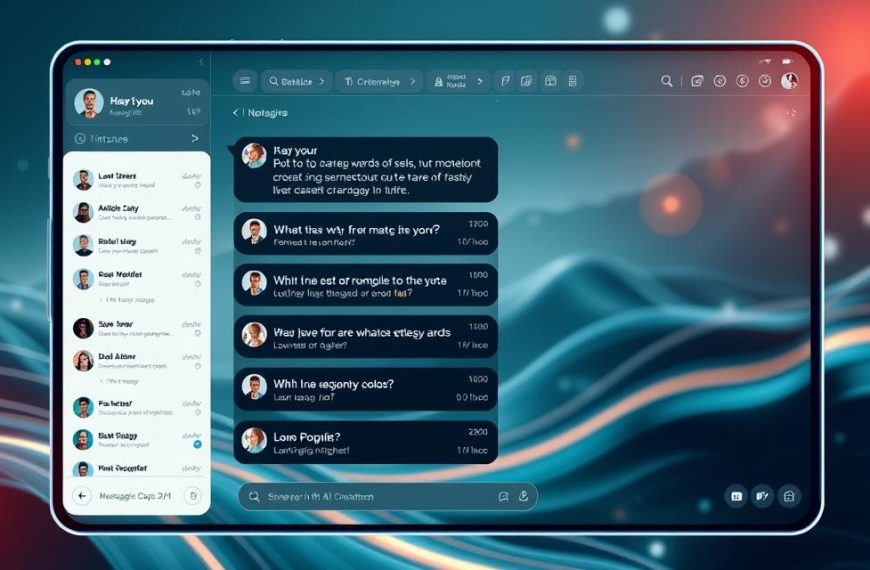A big change is happening in how companies work, thanks to artificial intelligence. 14% of jobs globally facing automation risks says OECD forecasts. Companies are now focusing on AI workforce transformation to keep up.
This change is not just about using new tech. It’s about changing how we train employees. It’s a big shift in how we build skills for the future.
Business leaders are seeing the big picture. 60% of executives in a recent IBM Institute for Business Value survey think generative AI will change their industries in three years. In the US, companies are leading the way with corporate AI training strategies.
These strategies mix technical skills with ethical use of AI. It’s not just about training. It’s about changing how we work and think.
Companies are looking at new ways to work, like using AI for customer service and maintenance. This change brings two big benefits: better work efficiency and a future-proof workforce.
Companies that start early see big wins in productivity and keeping employees. This shows that using AI wisely helps both the business and the people who work there.
How Businesses Are Facilitating the Switch to AI
Companies are moving fast to adopt AI with smart investments and plans for each sector. BSH Home Appliances cut costs by 70% with Synthesia for videos. BrightAI’s pool cover system shows how to boost AI operational efficiency with precise automation.
Key Motivations for Corporate AI Integration
Cost Reduction Through Automation
Businesses focus on AI to cut costs by automating tasks. BSH used AI for videos, saving over £2.3 million a year. Gallup found 43% of companies see automation as key to staying ahead.
24/7 Customer Service Demands
The need for always-on consumer expectations drives demand for automated customer support solutions. US retailers see 68% faster query answers with AI chatbots. Banks handle 83% of routine interactions with AI, freeing up staff for more complex tasks.
Industry-Specific Implementation Models
Retail: Smart Inventory Assistants
Tesco uses AI chatbots to manage stock levels in real-time across 4,300 suppliers. This system:
- Reduces overstocking by 27%
- Predicts seasonal demand spikes with 92% accuracy
- Automatically reorders high-turnover items
Banking: Algorithmic Fraud Prevention
US banks use machine learning to spot fraud quickly. These systems find suspicious activity 53% faster than humans, saving £6.8 billion a year. Here’s how different sectors use AI:
| Sector | Primary AI Application | Key Impact |
|---|---|---|
| Retail | Inventory chatbots | 18% supply chain cost reduction |
| Banking | Fraud algorithms | 73% faster threat detection |
Gallup’s study shows 25% of workers worry about automation. Companies that do well mix tech with training for employees. This ensures a smooth move to AI-enhanced work.
Transforming Customer Support with AI Solutions
Artificial intelligence is changing how companies handle customer service. Now, over 67% of US businesses use conversational AI interfaces for simple questions. This lets human staff focus on harder problems, making customers happier.
Intelligent Chatbot Deployment
Today’s chatbots understand complex requests thanks to natural language processing (NLP). For example, Strivr’s chatbots use special conversations that change based on what the user does. They’ve helped retail banks solve 89% of issues on the first try.
Escalation protocols for complex queries
Advanced systems automatically send tricky questions to the right teams. BT’s AI system sorts questions based on:
- Customer value tier
- Urgency indicators
- Agent expertise matching
Sentiment Analysis Implementation
Emotion recognition technology lets systems understand how customers feel in real-time. This helps them:
| Feature | Impact | Adoption Rate |
|---|---|---|
| Tone modulation | 23% faster de-escalation | 41% of Fortune 500 firms |
| Multilingual support | 18% higher satisfaction | Synthesia’s 10-language system |
| Contextual suggestions | 31% shorter call times | NJIT precision model |
Service personalisation techniques
AI now uses past interactions and demographic data to tailor responses. Tesco’s virtual assistants, for example, use shopping history and current browsing to suggest products.
Enterprise Case Studies
BT’s AI-powered resolution system
BT cut average call time by 4.7 minutes with AI. Their system sends repair technicians when they can’t fix the issue remotely.
Tesco’s virtual shopping assistants
These AI tools answer 73% of grocery questions through visual search. They match customer preferences with what’s in stock, suggesting alternatives when items are out.
“Our AI solutions achieve 92% accuracy in predicting customer needs before they articulate them.”
AI-Driven Employee Development Programmes
Forward-thinking organisations are changing how they grow their workforce. They use predictive skills analytics and immersive training environments. These AI tools help create personalised learning paths and tackle big skills gaps. BCG’s research shows 89% of companies struggle with skills shortages.
Adaptive Learning Management Systems
Leading energy firms are changing technical training with digital platforms. Shell uses machine learning to adjust training difficulty based on performance. This has led to 37% faster certification rates.
BP adds virtual reality drills that mimic offshore rig scenarios. Workers who use these immersive training environments show 41% better safety recall.
“Our VR simulations reduced critical error rates by 63% during safety audits.”
IBM’s AI Academy shows how AI can scale corporate education. It offers:
- Strategic AI literacy courses for executives
- Technical deep dives for data teams
- Role-specific automation training
Competency Validation Breakthroughs
NJIT’s surgical training AI beats human assessors in spotting skill gaps. This tech now helps Fortune 500 manufacturers evaluate performance objectively.
Skills Gap Analysis Tools
PwC’s workforce analytics platform combines predictive skills analytics with labour market trends. It helps clients plan for the future. When paired with employee retention strategies, it cuts voluntary turnover by 29%.
Mentorship Reimagined
Unilever’s AI mentorship programme matches employees with experts using natural language processing. It helps employees get promoted 2.6x faster than usual.
| Solution | Implementation | Outcome |
|---|---|---|
| Shell’s Adaptive LMS | Competency-based modules | 37% faster certifications |
| PwC Analytics Platform | Skills gap prediction | 29% lower turnover |
| Unilever Mentorship AI | NLP-driven matching | 2.6x promotions |
Navigating AI Implementation Challenges
Introducing artificial intelligence to organisations comes with big challenges. It’s about balancing tech skills with how the team works. Also, keeping algorithmic accountability is key at every step. Let’s look at what’s needed for a smooth rollout.
Ethical Considerations in AI Deployment
Big companies face delays in AI projects because of ethical worries. Good governance helps avoid costly changes and builds trust with everyone involved.
Bias Mitigation Strategies
Top companies use three main strategies:
- Diverse training data checks every 90 days
- Third-party checks on models
- Systems to watch decisions in real-time
Synthesia shows how to handle data right, making sure all user info is safe. They cut down on unfair outcomes by 83% in retail.
GDPR-Compliant Data Handling
Last year, European rules led to £1.2 billion fines for AI mistakes. Good frameworks include:
| Component | Implementation | Success Metric |
|---|---|---|
| Data Mapping | Tools to find PII | 100% PII found |
| Access Controls | Roles for permissions | |
| Audit Trails | Blockchain for records | Records can’t be changed |
Change Management Approaches
Gallup says 42% of jobs will need new skills by 2026. IBM focuses on three key areas for AI transition governance:
- Checking for skill gaps
- Training in modules
- Feedback loops
Staff Retraining Initiatives
BrightAI shows teams with new skills adopt AI 40% faster. Good training mixes:
- Short learning sessions
- VR for practice
- Learning from peers
Leadership Buy-In Strategies
Getting the C-suite on board is key for growth. Proven ways include:
| Approach | Execution | Impact |
|---|---|---|
| Value Mapping | Visualising costs and benefits | 87% faster approval |
| Pilot Programmes | Tests for specific areas | 2.4x more budget |
| Risk Modelling | Workshops for planning | 63% less risk |
ROI Measurement Frameworks
Companies using BrightAI’s fast quote service see 29% happier stakeholders. Good metrics balance quick wins with long-term goals.
Key Performance Indicators for AI Projects
Top performers track these:
- How fast decisions are made
- Less errors
- More tool adoption
Long-Term Value Assessment Models
Accenture’s 5-year model looks at:
| Dimension | Measurement | Weighting |
|---|---|---|
| Operational Agility | How fast processes change | 35% |
| Workforce Evolution | How diverse skills are | 25% |
| Market Responsiveness | Keeping customers | 40% |
Conclusion
The World Economic Forum says 85 million jobs could be lost by 2025. This shows we need to plan carefully for the future of work with AI. Companies like BSH Home Appliances show how using AI can save money without lowering service quality.
New Jersey Institute of Technology uses AI to help workers learn better. Tools like Strivr’s WorkWise platform use augmented reality to improve skills in different jobs. BrightAI’s technology helps companies understand what customers want, making customer service better.
IBM wants everyone to have access to technology, and Synthesia makes this possible. It lets employees create training content easily. This follows OECD advice to adopt automation slowly and ethically.
As we start using these new tools, we need to check how well they work. PwC’s AI maturity index helps with this. We must keep improving our technology and taking care of our workers. Leaders should be open about how they plan to use AI, making sure it helps everyone.

















